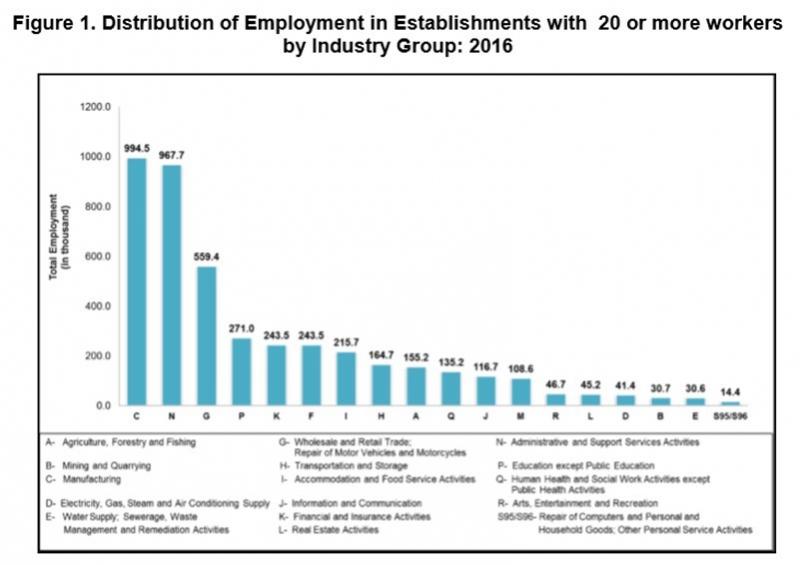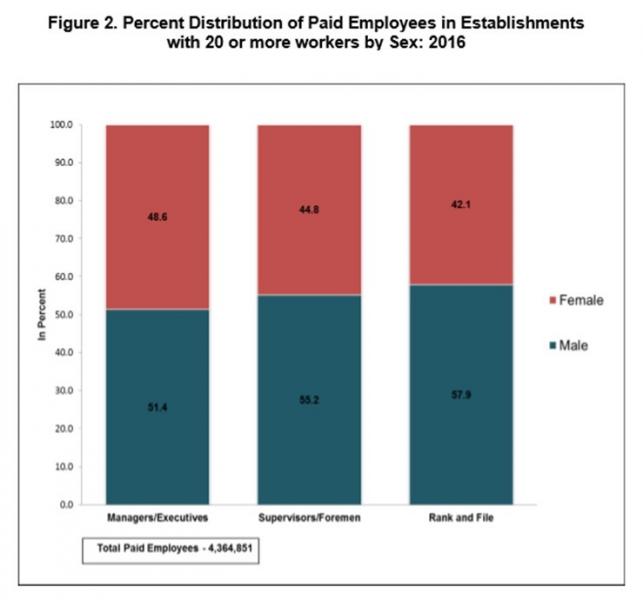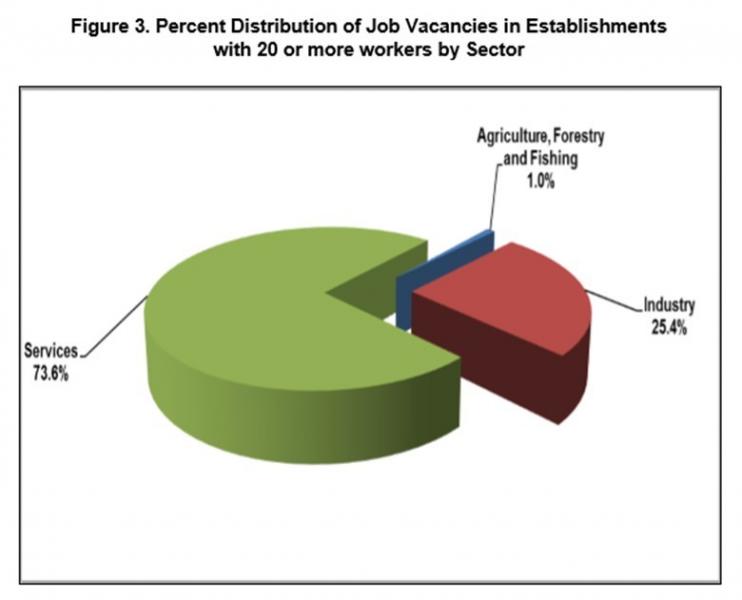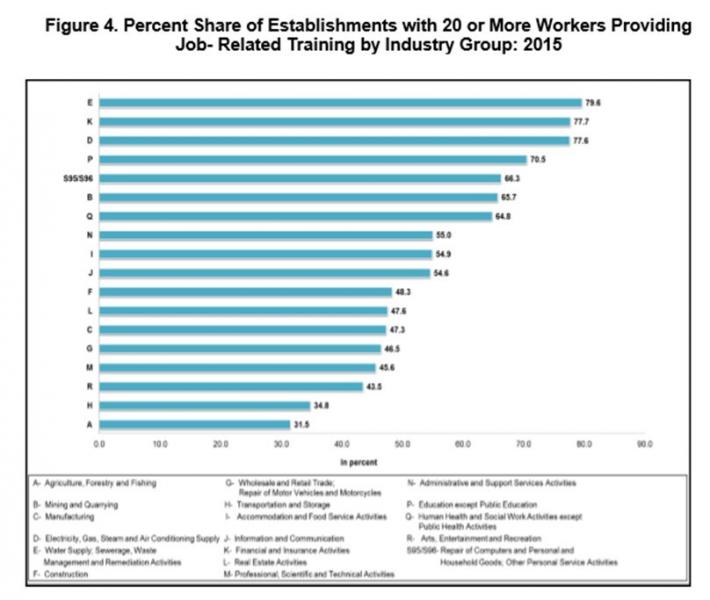Release Date :
Reference Number :
2017-127
HIGHLIGHTS
EMPLOYMENT
Employment reaches 4.38 million in 2016
- Total employment in establishments with 20 or more workers was estimated at 4,384,678 in June 2016.This was lower by 2 percent relative to the June 2014 total count of 4,471,785.
- Among the industry groups, manufacturing had the highest employment with 994,455 workers or 22.7 percent of the total employment. The administrative and support services activities ranked second with 967,699 (22.1%), while wholesale and retail trade followed with 559,419 workers or 12.8 percent.

Two in every five workers are females
- Out of the estimated total employment, 42.7 percent were females.
- Paid employees comprised 99.5 percent of the total employment while the remaining 0.5 percent were working owners and unpaid workers.
- 3.8 million employees or 87.1 percent of the total paid employees belonged to the rank and file workers, of which 42.1 percent were females.
- Managers/executives and supervisors/foremen had combined share of 12.8 percent of the total paid employees, of which 46.4 percent were females.

Manufacturing employs most number of persons with disability (PWDs)
- Of the total 4.38 million employed, 3,504 workers were PWDs. The highest number of employed PWDs was registered in manufacturing at 34.5 percent. This was followed far behind by establishments engaged in education (11.8 %) and by wholesale and retail trade at 9.4 percent.
More than half of the total establishments hire workers through recruitment agencies
- About 54.7 percent of establishments employing 20 or more workers engaged the services of agency-hired workers. The top three industries in terms of the number of agency-hired workers were wholesale and retail trade (22.8%); manufacturing (21.9%); and accommodation and food services (13.3%).
OCCUPATIONAL SHORTAGES AND SURPLUSES
Services sector accounts for the bulk of the job vacancies
- More than half (51.6% or 16,144) of the establishments reported job openings in their firms any time between January 2015 to June 2016. The total number of available job openings was placed at 698,683 during the period.
- Services sector reported the most number of vacancies at 514,060 or 73.6 percent of the total. The industry sector accounted for 177,889 vacancies or 25.4 percent while the agriculture, forestry and fishing sector posted the least number of job openings with only 6,733 or 1.0 percent of the total job openings.

TRAINING OF WORKERS
More than half of the establishments provide job-related training
- Job-related training of workers were provided by 53.0 percent of the 30,682 total establishments in 2015.
- Across industries, the largest proportion of establishments that provided training was in water supply; sewerage, waste management and remediation activities (79.6 %), followed by financial and insurance activities (77.7 %) and electricity, gas, steam and air conditioning supply (77.6%). In contrast, the lowest share was recorded in agriculture, forestry and fishing industry (31.5%).

Definition of Terms
Establishment- an economic unit engaged in one or predominantly one kind of economic activity under single ownership
Employment - persons who worked or received pay from the establishment.
Includes:
- working owners with or without regular pay
- salaried directors, managers and executives
- regular and non-regular workers, e.g., probationary, casual, contractual/project-based, seasonal and paid apprentices/learners
- persons on paid vacation, sick, maternity, paternity, service incentive leave and other paid leaves
- persons working away from the establishment but paid by and under its control, e.g., bus drivers
- workers on strike/lockout
- unpaid workers without regular pay who work for at least 1/3 of the working time normal to the establishment including apprentices without compensation or student on-the-job trainees
Excludes:
- silent or inactive partners
- members of the board of directors paid solely for attendance at meetings
- consultants, persons on retainer basis, contract out/agency hired workers, homeworkers
- workers on indefinite leave, laid off workers for six (6) months or more
- persons purely on commission and without employer control
Working Owners - working owners who do not receive regular pay.
Unpaid Workers - persons without regular pay who work for at least one-third of the working time normal to the establishment. Apprentices without compensation or student on-the-job trainees are included.
Employees - categorized into:
- Managers and Executives - workers whose main responsibilities are to determine and formulate policies and plan, direct, control and coordinate the activities of enterprises and organizations, or their internal departments or sections. Working owners receiving regular pay are included;
- Supervisors/Foremen - workers whose main responsibilities are to plan, direct, organize and supervise the daily activities of workers in the section or unit concerned with the production of goods or the provision of services, subject to the general directive of managers; and
- Rank and File Workers - workers who do not fall within the managerial or supervisory classification of employees. These consist of:
i. Regular Workers - workers hired to perform activities which are usually necessary or desirable in the usual business or trade of the employer and usually worked on permanent status; and
ii. Non-Regular Workers - consist of probationary workers, casual workers, contractual/project-based workers, seasonal workers, apprentices/learners.
Female Workers - women working as working owners, unpaid workers or employees.
Persons with disabilities (PWDs) - workers who have physical, mental or sensory impairments which may hinder their full and effective participation in the workplace on an equal basis with others.
Agency-hired workers - workers employed by the contractors to perform or complete job, work or service pursuant to a service agreement within the premises of the establishment. They are excluded from the total employment of the establishment.
Job Vacancies - refer to unfilled job openings, which are immediately available for placement and for which active recruitment steps are being undertaken anytime during the reference period.
Job-related Training - include trainings conducted by the establishment and those which were offered by other institutions but are financed by the establishment.
LISA GRACE S. BERSALES, Ph. D.
Undersecretary
National Statistician and Civil Registrar General
See more at the Integrated Survey on Labor and Employment (ISLE) page.
